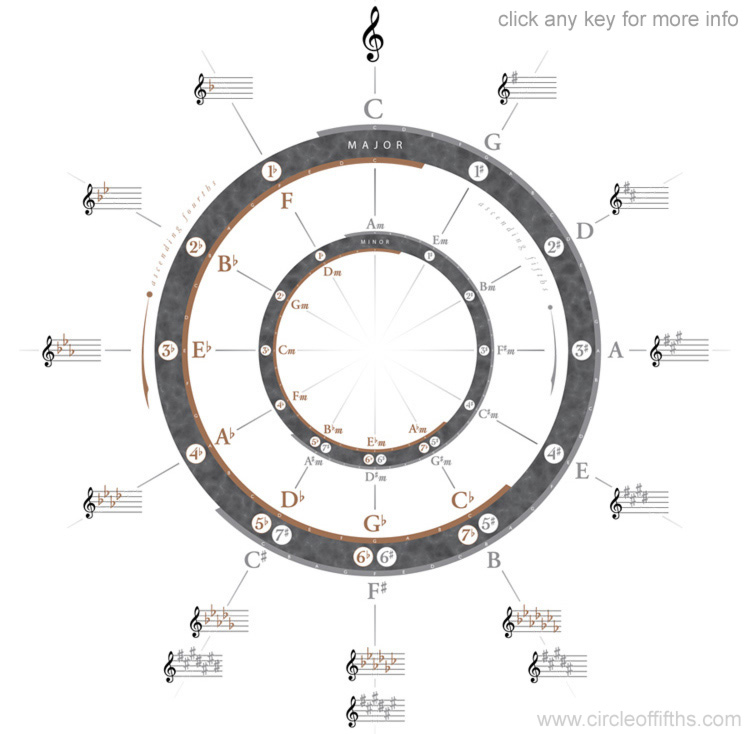So you’ve mastered the art of strumming a few chords and now you’re feeling like a musical genius, right? Well, hold onto your guitar picks, because we’re about to take your skills to a whole new level. Say goodbye to playing in just one key and hello to mastering chord progressions in every key imaginable. Get ready to impress your friends, annoy your neighbors, and maybe even serenade the local stray cats with your newfound expertise. Let’s dive into the wondrous world of musical keys and unlock the secrets to becoming a chord progression wizard.
Contents
- 1 Understanding the Building Blocks of Chord Progressions
- 2 Exploring Major and Minor Scales for Chord Construction
- 3 Navigating Through Common Chord Progressions
- 4 Applying Circle of Fifths to Enhance Your Progressions
- 5 Modulating Between Keys for Creative Progressions
- 6 Incorporating Advanced Chords and Extensions
- 7 Practical Exercises to Master Chord Progressions in Various Keys
- 8 FAQs
- 9 Now go forth and conquer those chords!
Understanding the Building Blocks of Chord Progressions
So you want to understand the building blocks of chord progressions, eh? Let’s break it down for you in a way even your great-grandma can understand!
First off, let’s talk about chords. These bad boys are made up of three or more notes played together to create a harmonious sound. Think of them like a delicious musical sandwich – the bread is the root note, the meat is the third, and the cheese is the fifth. Put them all together and you’ve got yourself a tasty chord!
Now, onto progressions. These are just sequences of chords played in a specific order. It’s like following a recipe - you need the right ingredients in the right amounts to make a tasty dish. Mix and match different chords in different orders to create your own musical masterpiece!
And lastly, understanding these building blocks is like learning a new language. The more you practice, the better you’ll get at speaking the musical language fluently. So grab your guitar, piano, or kazoo, and start experimenting with different chord progressions. Who knows, you might just come up with the next chart-topping hit!
Exploring Major and Minor Scales for Chord Construction
So you’ve decided to venture into the world of chord construction and need to brush up on your major and minor scales. Don’t worry, we’ve got you covered!
When it comes to major scales, think of them as the life of the party – always upbeat and full of energy. Major scales are like that one friend who can’t stop smiling and dancing even when the music stops. They are your go-to for creating bright and cheery chords that will have everyone tapping their toes.
On the flip side, minor scales are a bit more moody and dramatic. They are like the friend who always shows up wearing all black and listening to sad music. Minor scales bring depth and emotion to your chords, perfect for when you want to add a touch of melancholy or mystery to your compositions.
So, next time you’re working on chord construction, remember to play around with both major and minor scales to create a harmonious blend of joy and sorrow. Mix and match them to your heart’s content and watch as your music takes on a life of its own!

So you’ve finally picked up your guitar and decided to dive into the world of chord progressions. Well, buckle up because you’re about to embark on a musical rollercoaster ride!
First up, we have the good ol’ I-IV-V progression. This is the classic trio of chords that can be found in countless songs across various genres. Remember to strum confidently and bob your head like you’re playing at Madison Square Garden.
Next, let’s talk about the vi-IV-I-V progression. This one’s like the hipster of chord progressions – a bit offbeat, but undeniably cool. Master this progression and you’ll be the envy of all your musician friends.
And finally, we have the ii-V-I progression. Think of this one as the sophisticated older sibling of the chord progression family. It exudes class and elegance, so make sure to play it with finesse and grace.

Applying Circle of Fifths to Enhance Your Progressions
So you’ve finally mastered the basics of music theory and now you’re ready to take your progressions to the next level with the Circle of Fifths. This ancient and mystical tool can help you create more interesting and dynamic chord progressions that will have your audience grooving in no time.
When applying the Circle of Fifths to your progressions, remember that it’s all about moving in a clockwise direction through the circle. This means that you’ll be moving from keys with fewer sharps to keys with more sharps – or from keys with fewer flats to keys with more flats. It’s like a musical game of hopscotch, but with more sharps and flats than you can shake a stick at!
One of the most useful ways to use the Circle of Fifths is to help you find the perfect chord substitutions for your progressions. By following the circle, you can easily identify chords that will add tension and interest to your music. It’s like having a secret decoder ring for chords – except way cooler.
So don’t be afraid to dive into the Circle of Fifths and let it guide you on your musical journey. Whether you’re a seasoned pro or a beginner just starting out, this ancient tool is sure to enhance your progressions and take your music to the next level. Just remember to always keep the circle spinning – and never be afraid to get a little sharp or flat along the way!

Modulating Between Keys for Creative Progressions
Have you ever found yourself stuck in a musical rut, playing the same old progressions over and over again? Well, it’s time to shake things up and get creative with your music by modulating between keys! Modulating between keys can add a whole new dimension to your progressions and keep your audience on their toes. Plus, it’s a great way to flex those musical muscles and challenge yourself to think outside the box.
So, how exactly do you go about modulating between keys? Here are a few tips to get you started:
- Choose your starting key: Before you can modulate, you need to know where you’re starting from. Pick a key that you’re comfortable with and build your progression from there.
- Find your destination key: Once you’ve established your starting key, think about where you want to go next. Be bold and experiment with different keys to see what works best for your song.
- Smooth out the transition: Modulating between keys can be a jarring experience if not done properly. Make sure to use chord progressions and melodic lines that help smooth out the transition from one key to the next.
By modulating between keys, you’ll add a touch of excitement and unpredictability to your music that will keep your listeners engaged and coming back for more. So go ahead, embrace the challenge and start experimenting with different key changes in your progressions. Who knows, you might just stumble upon a musical masterpiece!
Incorporating Advanced Chords and Extensions
So you think you’ve mastered basic chords? That’s cute. Now it’s time to take your musical skills to the next level by incorporating some advanced chords and extensions. Get ready to blow everyone’s minds with your newfound harmonic sophistication!
First up, let’s talk about seventh chords. These bad boys add an extra layer of complexity to your compositions, giving them that extra spicy flavor that will make your listeners sit up and take notice. Start incorporating some dominant seventh, major seventh, and minor seventh chords into your repertoire, and watch as your music suddenly sounds a million times cooler.
Next, let’s delve into chord extensions. These fancy-sounding additions take your chords to a whole new dimension, making them sound rich and full. Experiment with ninths, elevenths, and thirteenths to add some serious depth to your music. Who needs basic triads when you can have all these juicy extensions to play around with?
And finally, don’t forget about altered chords. These bad boys are like the rebels of the chord world, adding unexpected twists and turns to your progressions. Play around with altered fifths, ninths, and thirteenths to create some seriously unique sounds that will set your music apart from the rest.
Practical Exercises to Master Chord Progressions in Various Keys
In order to truly master chord progressions in various keys, it’s essential to practice regularly. One fun and effective way to do this is by incorporating practical exercises into your routine. Try these out for size:
**1. Key Change Kaos:** Pick a familiar chord progression and play it in one key. Then, challenge yourself to switch to a different key without missing a beat. This exercise will not only test your knowledge of different keys but also improve your ability to transition smoothly between them.
**2. Chromatic Challenge:** Choose a random starting key and play a simple chord progression (such as I-IV-V-I) in that key. Then, move up or down the chromatic scale, playing the same progression in each new key. This exercise will help you become more comfortable playing in keys you may be less familiar with.
**3. Random Root Ramble:** Write down a list of different keys on separate pieces of paper and place them in a hat. Draw a key at random and challenge yourself to come up with a unique chord progression on the spot. This exercise will help you think on your feet and improve your improvisational skills.
By incorporating these practical exercises into your practice routine, you’ll be well on your way to mastering chord progressions in various keys. So grab your instrument, get creative, and start exercising those chord muscles!
FAQs
What’s the secret to mastering chord progressions in every key?
Well, the secret is actually pretty simple – practice, practice, practice! The more you work on playing chords in different keys, the more comfortable you’ll become with them.
Do I really need to learn chord progressions in every key?
Yes, absolutely! If you want to be a versatile musician who can play in any key, it’s important to master chord progressions in every key. Plus, it will open up a whole new world of musical possibilities for you!
How can I remember all the different chord progressions?
One way to remember all the different chord progressions is to use mnemonic devices or create cheat sheets to help you keep track of them. And of course, the more you practice, the easier it will become to remember them!
Are there any shortcuts to mastering chord progressions in every key?
While there are no easy shortcuts, one tip is to focus on learning the most common chord progressions first, as they show up in a lot of songs. This way, you’ll be able to apply them to a wide variety of music!
How can I make practicing chord progressions more fun?
One way to make practicing chord progressions more fun is to play along to your favorite songs or jam with other musicians. You can also try experimenting with different rhythms or adding your own personal flair to the chords!
Now go forth and conquer those chords!
Congratulations, you’ve now armed yourself with the knowledge and skills needed to master chord progressions in every key. So go ahead, grab your instrument of choice, play around with different chord progressions, and watch as your music skills soar to new heights! Remember, practice makes perfect, so don’t be afraid to experiment and try out new things. Happy jamming!



